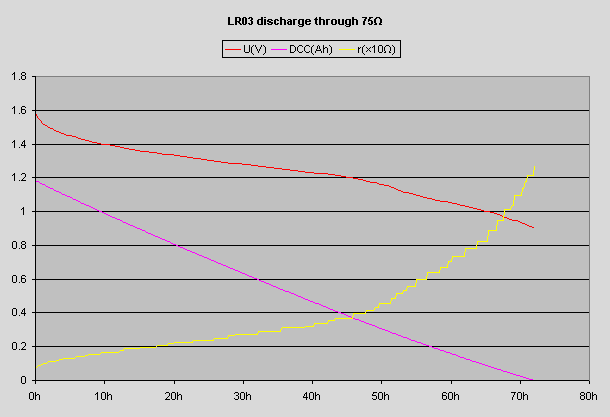a bit processing ::
and we have some fuzzy insights based on my own LR03 stats. - based on 60 AAA-s @ various discharge using ε(r) relation ::
| Load (Ω) | dt (s) | Eε(U) (V) | Er (Ω) | I (mA) | ΔC (mA·h) |
| 3.9 | 23.4 | 1.49(1.11) | 1.31 | 285 | 735 |
| 5.1 | 32.5 | 1.47(1.14) | 1.44 | 224 | 876 |
| 20 | 132 | 1.32(1.14) | 3.22 | 56.9 | 1058 |
| 24 | 194 | 1.37(1.25) | 2.34 | 52.2 | 1025 |
| 75 | 619 | 1.29(1.23) | 4.07 | 16.3 | 1180 |
| Load (Ω) | Fresh | Exhausted | ||||
| ε(U) (V) | r (Ω) | I (mA) | ε(U) (V) | r (Ω) | I (mA) | |
| 3.9 | 1.69*(1.49) | 0.533 | 381 | 1.38(.902) | 2.07 | 231 |
| 5.1 | 1.67*(1.5) | 0.573 | 294 | 1.34(.907) | 2.46 | 178 |
| 20 | 1.57(1.5) | 0.88 | 75.1 | 1.17(.901) | 6.09 | 45 |
| 24 | 1.62(1.57) | 0.71 | 65.5 | 1.21(.998) | 5.07 | 41.6 |
| 75 | 1.6(1.57) | 0.771 | 21 | 1.05(.902) | 12.7 | 12 |
reprocessed web LR03 stats. ::
| * -- | /!\ | The source site refers their device falling into initial EMF range of 1.58...1.65V - since the corresponding values for 3.9 and 5.1 Ω tests exceed the range it must be assumed that update : as i always post-error-check my ramblings (((a programmers special disease :: the prog-s're huge - the 'puter responce is always at some extent unpredictable - so it makes more sense to write your code - then multiple pass dis-errorize it - you can't avoid unknown error conditions in advance - even if there's no programmatic (code-flow) errors - you should still verify it does what it suppose to e.c e.c))) - so the update - it seems the QC passed a quite common 1 "a sign error" - it appares the higher the TEST resistance the higher the EMF(electro-motoric force for the battery (we need it actually to be lower here)) - /!\ there is actually such intermediate term phenomena as the more current is drawn from battery the better it performs (the higher the EMF temporarily climbs) - which might explain the higer startup EMF for lower resistance TESTs - i must make tests of my own to verify such -- for NOW what is known is that if we /!\ /!\ ALTER the "battery formula" ε = 1.5371 r-0.1493 >> ε = 1.25 r-0.5 then it'll show better correlation for that very dependency throughout the different TESTs . . . /!\ yes ? - should it ... | /!\ |
NB! -- this is just apx. guide line -- there is no any real instance of LR03 presented on those graphs
PS! -- notice that the unit for the internal resistance here is not the conventional and is varying by graph.


-60.GIF)





No comments:
Post a Comment